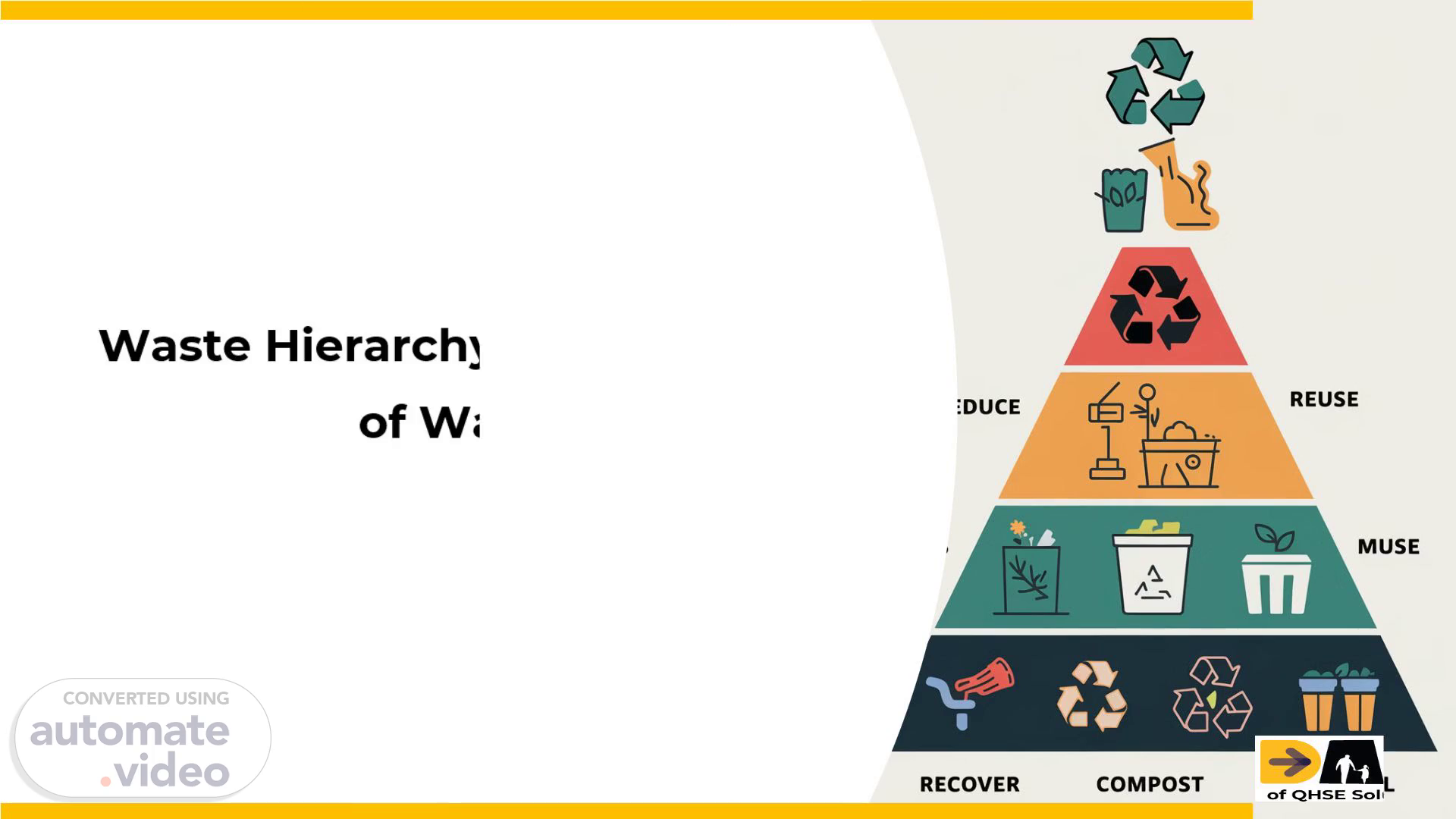Scene 1 (0s)
DUCE RECOVER ege COMPOST REUSE MUSE iiii LANDFILL.
Scene 2 (8s)
Table of Contents. Aim/Scope. Objectives. Objectives/Purpose.
Scene 3 (24s)
REUSE REUSE \ Illi RECYOSE. Aim/Scope. Understanding Waste Hierarchy.
Scene 4 (47s)
Objectives / Purpose. Understand the Waste Hierarchy.
Scene 5 (1m 13s)
dHN.bOH *0-aas MIOlXVdV VIDUUd enol Nouvo-ä03-s axsvm USVM.
Scene 6 (1m 46s)
PREVENTION REUSE RECYCLE RECOVERY DISPOSAL. Module 1.
Scene 7 (1m 54s)
Introduction to Waste Management. Global Waste Issues.
Scene 8 (2m 18s)
REUSE REUSE RECOVERY. The Waste Hierarchy Explained.
Scene 9 (2m 41s)
Waste Prevention Techniques. Personal Waste Prevention.
Scene 10 (3m 16s)
Minimization and Source Reduction. Smart Purchasing.
Scene 11 (3m 42s)
Reuse: Giving New Life to Old Products. Furniture Refurbishing.
Scene 12 (4m 18s)
Recycling: Turning Waste into Resources. Recyclable Materials.
Scene 13 (4m 45s)
AROViER REOWERY ARROXH REUSE RECYCLING SYMBLL COMPOST PILE.
Scene 14 (5m 10s)
qppfiajces OPFliances. Module 2. Waste Segregation Techniques and Importance.
Scene 15 (5m 18s)
ORGANIC LABLE RAL WASTE iiiiiiiuu HAZARDOUS. Overview of Waste Types.
Scene 16 (5m 42s)
-nuat.lvn ON11SOdLNOO. Importance of Waste Segregation.
Scene 17 (6m 6s)
Color-Coded Segregation. RfCiCl//lC PIPER cow. Global Standards.
Scene 18 (6m 38s)
Handling and Storage of Hazardous Waste. Safety Protocols.
Scene 19 (7m 11s)
PROPER WASTE. SECREOATION WASTE SECRECTIO. Challenges and Solutions in Waste Segregation.
Scene 20 (7m 44s)
Module 3. Practical Applications in Waste Management.
Scene 21 (7m 52s)
PLASTIC ORGANIC WASTE. Waste Management in Households.
Scene 22 (8m 19s)
Waste Segregation in Offices. Paper Waste. Offices generate a significant amount of paper waste, including printouts, documents, and envelopes. Implementing a dedicated paper recycling program can help reduce this waste stream and promote sustainability..
Scene 23 (8m 49s)
Waste Segregation in Industries. 1. Industrial Waste Types.
Scene 24 (9m 19s)
Community Waste Segregation Programs. 'V. Organizing Segregation.
Scene 25 (9m 51s)
GREEN RECYCLING COST SAVINGS EMISSIONS REDREGATION.
Scene 26 (10m 24s)
Practical Session: Case Study. Analyze Waste Segregation.
Scene 27 (10m 49s)
Quiz. Waste hierarchy places disposal as the first priority. (No).
Scene 28 (11m 17s)
Feedback. Of QHSE Solutions.
Scene 29 (11m 24s)
Thank you. Of QHSE Solutions.
